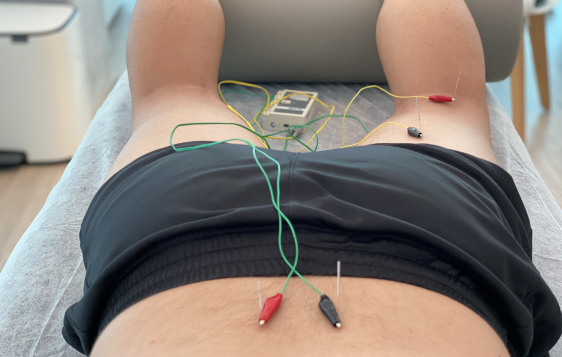Percutaneous neuromodulation
Ultrasound-guided percutaneous neuromodulation technique is defined as the use of an ultrasound-guided needle to produce electrical stimulation of a peripheral nerve at a point along its path or of a muscle at a motor point, with a therapeutic objective.
That is, we use a puncture needle associated with a low or medium frequency electrical current to induce a sensory and/or motor response by stimulating the peripheral nerve.
A technique which, in short, allows us to stimulate the peripheral nerve very precisely at the root level and along its path.
In the interest of safety and effectiveness, this technique must be applied while using ultrasound. The professional performing ultrasound-guided physiotherapy must be highly-knowledgeable of human anatomy.
The application is based on stimulation using a puncture needle associated with a low or medium frequency electrical current, in order to induce a sensory and/or motor response by stimulating the peripheral nerve, or to achieve a motor response by stimulating the motor point.
We should remind you that neuromodulation is a safe, effective technique that is practically painless. Percutaneous neuromodulation is one of the most requested techniques among our patients.
Because this therapy offers a shorter recovery time and better prognosis, it has earned a place for itself among workers and athletes who practice diverse sports, for whom this type of therapy can positively impact the treatment of their injuries and even improve their athletic performance. Next, we present a series of indications and contraindications associated with the application of this technique. The contraindications, as you can see, are based exclusively…

INDICACIONES
• Hernias discales, cervicobraquialgias, ciáticas
• Cefaleas, neuralgias craneales
• Dolor neuropático (dolor que genera el nervio)
• Dolores musculoesqueléticos
• Mejora de la activación/control neuromuscular
• Perdida de sensibilidad
• Inestabilidad articular
• Roturas musculares
Contraindications:
• Fear of needles
• Clotting problems
• Allergies to metals (such as nickel; although there are needles made of a number of different materials, an evaluation must be made and taken into account)
• In pregnant women (in areas close to the pelvic and abdominal regions)
Por existir este tipo de problemas, y por ser una técnica invasiva a lo que no todo el mundo está acostumbrado, es necesario que el fisioterapeuta explique bien todo el proceso antes de emplear la técnica, dándole al paciente información sobre ventajas, inconvenientes y también sobre otras alternativas de tratamiento.
En nuestra Clínica te haremos un estudio pormenorizado: veremos si es lo más adecuado para tu caso, te explicaremos el proceso y te daremos toda la información necesaria para abordar con garantías este tipo de técnica.
Frequently Asked Questions on Percutaneous Neuromodulation
What is percutaneous neuromodulation and how does it work?
Percutaneous neuromodulation is an advanced technique that uses fine needles connected to an electrotherapy device to stimulate specific nerves, with the goal of reducing pain and improving muscle function.
This stimulation is performed in a guided manner, targeting the affected areas directly and providing fast and long-lasting relief.
What are the benefits of percutaneous neuromodulation in pain treatment?
Percutaneous neuromodulation is highly effective in reducing pain as it directly targets the affected nerves and muscles. This technique helps decrease inflammation, relax muscles, and improve mobility, allowing for a faster recovery.
It is also an excellent option for patients with chronic pain or injuries that have not responded well to other treatments.
What types of injuries or conditions are treated with percutaneous neuromodulation?
At Fisioclínica LH, percutaneous neuromodulation is used to treat a variety of conditions, including tendinopathies, lower back pain, sciatica, neck pain, and muscle contractures.
It is also effective for sports injuries and chronic pain, as it helps reduce muscle tension and improves the function of the nervous system.
Is percutaneous neuromodulation painful?
Percutaneous neuromodulation may cause mild discomfort during needle insertion and nerve stimulation. However, this discomfort is usually minimal and temporary.
At Fisioclínica LH, our professionals ensure the treatment is as comfortable as possible, and many patients find that the post-treatment pain relief outweighs any initial discomfort.
How many sessions of percutaneous neuromodulation are needed?
The number of sessions required varies depending on the severity of the condition and the patient’s response to treatment. In general, significant improvement is often noticed after the first few sessions.
At Fisioclínica LH, each treatment is personalised, and the physiotherapist will recommend the necessary number of sessions following an initial assessment.
How long does the effect of percutaneous neuromodulation last?
Pain relief and improved mobility can be immediate for some patients, while others may require a few sessions to notice significant changes.
Generally, the effects can last from several weeks to months, depending on the injury and the individual’s response to treatment. At Fisioclínica LH, progress is evaluated in each session to optimise results and adjust the treatment as needed.
Is percutaneous neuromodulation suitable for sports injuries?
Yes, percutaneous neuromodulation is an ideal technique for sports injuries as it allows precise targeting of injured muscles and nerves, speeding up recovery.
It is effective for treating tears, contractures, and common tendinopathies in athletes and can be combined with other physiotherapy methods for comprehensive recovery. At Fisioclínica LH, many athletes find this technique invaluable for reducing recovery time and preventing relapses.
